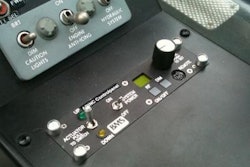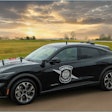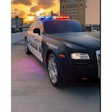For more than a decade now, the Ford Crown Vic Police Interceptor has been the nation's predominant law enforcement vehicle. The car is so commonly used by law enforcement that speeding motorists know to keep a keen eye out for its distinctive grille design in their rearview mirrors.
But the era of the Crown Vic is quickly coming to a close. It's expected that August of this year the last CVPI will roll off of the assembly line.
The end of the Crown Vic has heralded one of the most exciting eras in the history of law enforcement vehicles. This year Chevy is launching its new Caprice PPV. Dodge has developed a new and improved version of its Charger police package. And Ford is replacing the Crown Vic with the 2012 Next Generation Police Interceptor.
These are the first true 21st century police cars, and they each offer a variety of high-tech features. They have engine-control computers, high-intensity headlights, a vast collection of air bags. And they also have extremely sophisticated engines.
The internal combustion engine is essentially a very simple concept. Fuel is mixed with air in a combustion chamber and a spark is initiated to produce a controlled explosion. The energy from the explosion is translated to the wheels of the vehicle, and it zooms down the road. This concept really hasn't changed since the earliest days of the horseless carriage.
What has changed is the cost of fuel. Which means that customers are now demanding that automotive engine designers create powertrains that save fuel, but they also want as much or even more horsepower and torque. Saving fuel and boosting power would seem to be diametrically opposed concepts, but the Big Three American car companies are doing just that with their latest patrol car engines.
The new Caprice PPV is Chevy's first rear-wheel drive patrol sedan since the company discontinued its predecessor in 1996. Based on the Holden Commodore (an Australian General Motors product), the Caprice PPV will be produced in two versions: a 6.0-liter V8 model and a 3.6-liter V6.
First off the line for 2011 is the V8 configuration. The V8 engine used in the Caprice PPV is a fourth-generation Chevy small block that's been optimized for both power and fuel savings.
Computer controls on the Caprice's V8 powerplant enable what Chevrolet calls Active Fuel Management. This gas-saving feature essentially gives the Caprice two engines: one a four-cylinder econo drive for fuel efficiency and the other a powerful V8. "Active Fuel Management allows us to turn off four cylinders when coasting, which saves on fuel and emissions," says Dana Hammer, Chevrolet's manager for law enforcement vehicles.
The transition between four cylinders happens automatically based on the computer's analysis of throttle position, vehicle speed, engine temperature, and outside temperature. And the transition between the two modes is not readily apparent to the driver, according to Chevrolet.
"It's seamless to the customer," says Hammer. "You can display it on the driver's information panel but that's really the only way you can tell."
Performance testing of the V8 Caprice patrol package has yielded some impressive stats. At the Michigan State Police (MSP) evaluations, the new Caprice reached a top speed of 148 mph and accelerated from 0-100 mph in 14.77 seconds. Chevy specs detail that the Caprice's 6.0-liter V8 generates 355 horsepower at 5,300 RPM and 384 foot-pounds of torque when the tachometer hits 4,000 RPM.
The V6 Caprice PPV is scheduled to debut later this year as a 2012 model. Hammer says the car will be equipped with Chevy's new advanced 3.6-liter engine called the "High Feature V6" around GM but not currently branded.
While it's too early for GM to reveal any specs on this V6, the company will discuss some of the features. The engine will have direct injection, dual overhead cams, and variable valve timing.
It will also be matched with the same six-speed automatic transmission that's used on the V8 Caprice. "That's a big part of the performance picture for this car," says Hammer. "The six-speed automatic transmission allows a wider range of gear ratios with the transmission and a lower gear ratio in the differential. This helps us improve the fuel economy by lowering the RPMs."
Hammer believes it's not a fair comparison to match the new V6 up against any of Chevy's existing V6s. A more even match would be the new V6 against yesterday's V8s. "We will have performance that rivals the V8s of the past but with better fuel economy and lower emissions," he says.[PAGEBREAK]
For 2011, Dodge has redesigned the rear-wheel drive Charger Pursuit in two different configurations: a 5.7-liter Hemi V8 and a 3.6 Pentastar V6.
Chrysler's 5.7-liter Hemi is one of the most powerful engines available in an American sedan. At the 2011 MSP evaluations back in September the 5.7-liter Hemi Charger Pursuit ripped around the track at a top speed of 146 mph and scored a 0-100 mph acceleration time of 14.99.
The 5.7-liter Hemi in the Charger Pursuit is a true 21st century engine. It maximizes fuel efficiency by using variable valve timing to drop out four cylinders when they are not needed. But all the driver has to do is punch the pedal and the Charger's Hemi springs to life in all its glory. And it's a beast, generating 370 horsepower at 5,150 RPM and 397 foot-pounds of torque at 4,250 RPM.
For those agencies that prefer a less powerful squad but with plenty of ponies on demand, Dodge is offering the Charger with a 3.6-liter Pentastar V6.
The Pentastar offers all of the best features of a next-generation V6 and then some. It feature dual overhead cams, variable valve timing, and an innovative oil filter system. "It's certainly a lot more fuel efficient, a lot more powerful, and much more refined than our previous V6," says Alan Falkowski, manager of Chrysler's advanced engine engineering group.
Falkowski says his team of engineers had two basic goals at the beginning of the Pentastar development process: to maximize fuel economy and boost performance. They also wanted to minimize friction and simplify the engine.
"One of the technologies we applied was an oil pump that can vary its displacement," says Falkowski. "When the engine is idling and doesn't need a lot of oil, it makes a small oil displacement. When the engine needs more at high speeds, it pumps more. It also runs at different pressures."
The Pentastar's lubrication system is so sophisticated that it even regulates the piston cooling jets based on need. "We don't want to use those oil jets and waste oil at lower speed," explains Falkowski. "This has two advantages: It lets us run a higher compression ratio and it improves the durability of the pistons."
Chrysler's engineers were able to generate 40 more horsepower with the Pentastar than the previous generation of Charger V6. Yet the Pentastar is quieter and smoother running.
Falkowski says the engineers went out and tested all of the V6s on the market and set out to make the Pentastar even quieter than the best. "We made the engine structure very stiff and very light and were able to reduce the amount of noise that it radiates," he says.
The Pentastar is also smaller and lighter than the previous Charger V6. Falkowski says the size of the engine could literally save the lives of the customers. "The size and the north-south configuration allowed us to give the occupants more protection from impact," he explains. "The best way to manage an accident is to provide more crush space."
Chrysler rates the Pentastar for a 150,000-mile lifespan, but Falkowski considers that conservative. He and his engineering team made a serious effort to eliminate failure points. For example, they integrated the exhaust manifold into the cylinder head, eliminating the need for a gasket. They also mounted the oil cooler directly to the engine, eliminating connector hoses. "From the very beginning, we wanted to design out as many potential problems as possible," he says.
The 2011 Dodge Charger Pursuit with 3.6-liter Pentastar engine produces 291 horsepower at 6,400 RPM and 260 foot-pounds of torque at 4,400 RPM. At the MSP evaluations it ran 0-100 mph in 23.85 seconds.
[PAGEBREAK]Ford
Twenty years can be a really long time in terms of automotive engineering. When the Ford Crown Victoria Police Interceptor first rolled off the line in 1992, it was fitted with a 4.6-liter V8. And the CVPI has kept that same engine through its long service history. You couldn't buy a CVPI with a V6. But next year the CVPI will be replaced by Ford's 2012 Next Generation Police Interceptor, which is V6 only.
The new Ford comes in two configurations: a 3.5-liter V6 base model available in front-wheel or all-wheel drive and an AWD 3.5-liter EcoBoost V6 model.
Ford has dominated the Police patrol car market for more than a decade, and its new V6 squad represents quite a gamble. Fleet managers and auto writers are wondering: Will agencies go for front-wheel drive? Will they pay more for AWD? Will they buy into Ford's high-performance V6 concept?
The answers won't be known until next year. But one thing we do know at this point is that even the basic powertrain in the new Ford Interceptor offers plenty of power.
Ford says the 3.5-liter base V6 produces more than 280 horses at 6,250 RPM. That's at least 30 more ponies than the 2011 CVPI from an engine that burns a lot less fuel.
The power and the fuel efficiency of the Interceptor's base V6 is a product of high technology. For example, Ford has paired multi-valve dual overhead cam engineering with computer controlled twin independent variable cam shaft timing (Ti-VCT).
Brett Hinds, Ford's advanced engineering design manager, explains that the Ti-VCT feature allows the engine to respond to the driver's need for performance or for torque, according to commands from the car's computer.
"When you're sitting at idle in your patrol car, then you want really good fuel economy. So Ti-VCT phases the cams to a good fuel economy position," Hinds says. "Now let's say you get a call and you have to go off fast. Then it's time to use the full 280 horsepower. What happens then is Ti-VCT automatically changes the cam shaft timing for maximum performance."
In addition to Ti-VCT and dual overhead cams there are many other performance and efficiency features on the Interceptor's base V6. Hinds points to the car's tuned intake manifolds, which force extra air into the cylinder when needed. The spark system is also optimized for maximum efficiency on regular fuel. And the cooling system has been designed to prevent the engine from being knock-limited.
Hinds and other Ford engineers can talk about the base 3.5-liter Interceptor engine for hours. But what people really want to talk about is the EcoBoost.
Instead of a V8 in its top of the line patrol car, Ford opted for a turbocharged, direct injection 3.5-liter V6. Branded the EcoBoost, this engine may be small but it packs 365 horses at 5,500 RPM and 350 foot-pounds of torque over a tachometer range that begins at 1,500 RPM and rises to 5,250 RPM. The result is a V6 that can compete in power with a V8.
The Next Generation Interceptor was unofficially tested at the 2011 MSP evaluations; it's a 2012 model. But the scores were still impressive. Top speed maxed at 131 mph with limiters. More impressively, the EcoBoost AWD model accelerated from 0-100 mph in 15.3 seconds.
With its turbos and direct injection, the EcoBoost is a gasoline engine sporting diesel engine technology. Hinds says the turbos and DI "actually help each other out in producing power and efficiency. The sum is greater than the parts. It's like one plus one doesn't equal two; it equals something like 2.2."
Ford hasn't produced a gasoline-powered car with turbos since 1988. But Hinds says the company did not re-enter the turbocharged car market lightly. "We didn't just bolt turbochargers onto the base engine," he says. "It was engineered for it and we made upgrades along the way."
Hinds adds that the turbos on the EcoBoost-powered Interceptor do not suffer from turbo lag. "These are relatively small turbochargers-about the size of a softball," he explains. "And with direct injection and these turbochargers, you get virtually no turbo lag."
Turbos have long been a failure point on some very expensive cars, but Ford says the EcoBoost is rated for 10 years or 150,000 even for heavy police duty. "The EcoBoost was required to pass all Ford durability tests at peak horsepower and peak torque," Hinds says, adding that the turbochargers on the EcoBoost benefit from water cooling and a lubrication system that was engineered specifically for making the turbos durable.
Of course the turbochargers are only part of the power equation for the EcoBoost. The real star of this show is direct injection. In a direct injection engine, fuel is sprayed directly into the combustion chamber as opposed to spraying it into the intake manifold. The result is both better gas mileage and some serious power.
"Ford's EcoBoost is the only twin-turbocharged, direct injection gasoline engine in the world. And in the Interceptor we match it with a six-speed, police-tuned automatic transmission for a world-class powertrain," Hinds says.

















